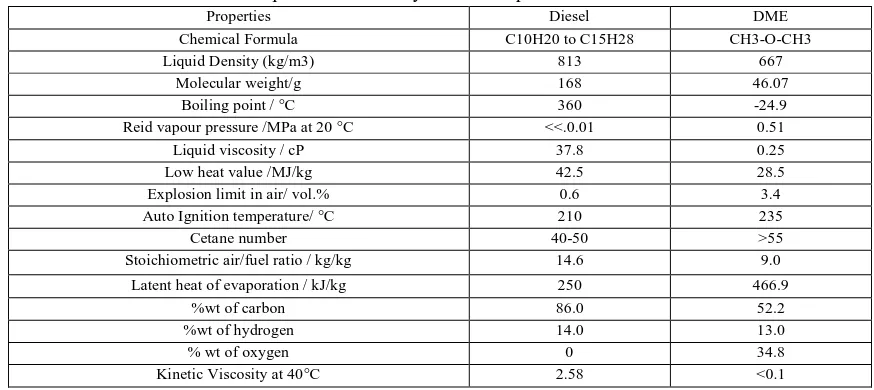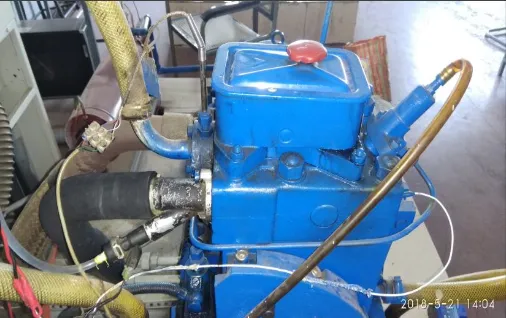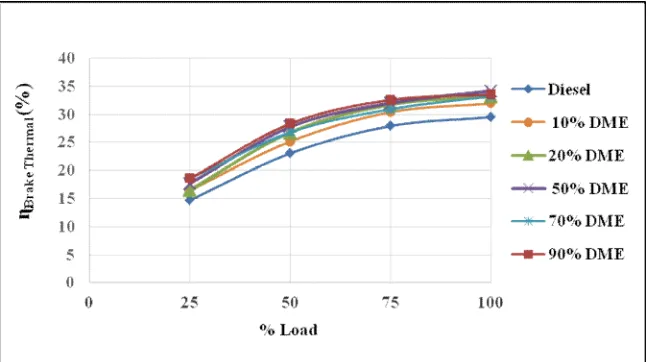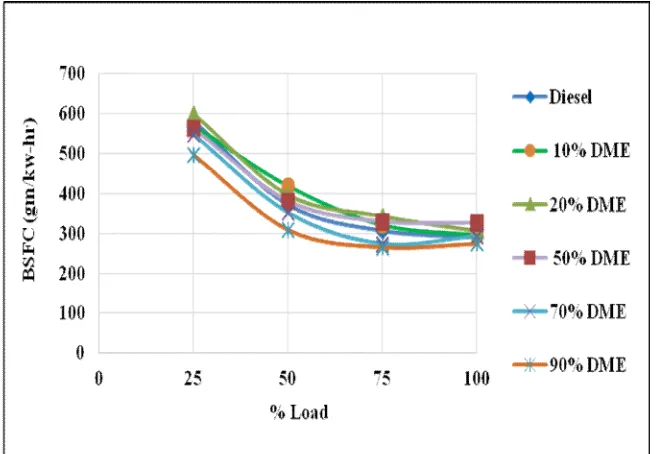Effect of Dimethyl Ether Port Injection on Direct
Injection Diesel Engine
Yogesh B Ambekar1, Dr. Jitendra A Hole2
1, 2
Mechanical Engineering Department, JSPM’S RSCOE, University of Pune, Maharashtra, India.
Abstract: To cope up with the exponentially rising energy demand in all over the world, an alternative fuel to the diesel must be considered. Natural gas, petroleum gas, hydrogen fuel, biodiesel, and electrically operated vehicles these are few alternatives for propelling the vehicles, but everyone has its own limitation of application. This paper examines dimethyl ether (DME), which is a potential ultra clean fuel, in duel fuel combustion with diesel fuel. DME has a heating value (41.0 MJ/kg) lower than that of diesel (about 42.5 MJ/kg) and LNG (about 50 MJ/kg) but higher than that of methanol (19.7 MJ/kg). Its vapor pressure is between that of propane and butane, so it can be handled as LPG. Therefore, DME is suitable for the modern diesel-powered engines.
Keywords:Dimethyl Ether, Duel fuel, Soot less emission, Port fuel injection, Clean energy source.
I. INTRODUCTION
[image:1.612.86.523.526.721.2]Recently, DME has been considered as an alternative to diesel fuel or LNG. The stringent Ultra Low Emission Vehicles (ULEV) regulations can be met by using DME as fuel. Regarding the use of dimethyl ether and diesel fuel blended together. Since only use of dimethyl ether reduces the durability of fuel system hardware, but DME with diesel as duel fuel will improve the lubricating quality of the fluid. Here, DME being oxygenated fuel, emission formation is controlled via in-cylinder combustion control. The goal of port injection of DME is providing better atomization and controlling the heat release rate is to allow soot particles to be oxidized through improved air entrainment and utilization. DME can be made from a variety of feed stocks, biological wastes, natural gas, which can support the use of alternative energy resources. DME gas can be store under low-pressure containers storage, which is very similar to those LPG. The storage, handling, distribution and safety aspects of DME are very similar to those of LPG, in order to the similarity in physical properties of these substances. One of DME’s most important characteristics is its low ignition temperature, which is similar to that of diesel fuel. Main advantages of the DME are its high oxygen content (35 %) and its high cetane number (> 55) which is higher than that of diesel fuel. It has been adopted as an additive for ignition improvement in alcoholic fuelled engines due to its excellent auto-ignition characteristics. This nature of DME combustion is responsible for the near-zero particulate emissions and low noise level during engine operation compared to diesel. These combustion characteristics make DME a promising alternative fuel for compression-ignition engines.
TABLE I
Properties of Dimethyl Ether compared with Diesel
Properties Diesel DME
Chemical Formula C10H20 to C15H28 CH3-O-CH3
Liquid Density (kg/m3) 813 667
Molecular weight/g 168 46.07
Boiling point / °C 360 -24.9
Reid vapour pressure /MPa at 20 °C <<.0.01 0.51
Liquid viscosity / cP 37.8 0.25
Low heat value /MJ/kg 42.5 28.5
Explosion limit in air/ vol.% 0.6 3.4
Auto Ignition temperature/ °C 210 235
Cetane number 40-50 >55
Stoichiometric air/fuel ratio / kg/kg 14.6 9.0
Latent heat of evaporation / kJ/kg 250 466.9
%wt of carbon 86.0 52.2
%wt of hydrogen 14.0 13.0
% wt of oxygen 0 34.8
II. METHODOLOGY
This experimental research paper presents the effect of multiple injection strategies on the neat dimethyl ether (DME) fuel atomization and reduction of exhaust emission characteristics within a compression ignition (CI) engine. Pilot and split injections under various injection mass (m inj.) and timing (t inj.) conditions as a multiple injection strategies were applied to reveal its effect on the improvement of spray atomization and the reduction of exhaust emissions in terms of spray tip penetration, rate of heat release (ROHR), indicated mean effective pressure (IMEP), and generation of exhaust emissions (such as CO, HC, NOX, and soot). These experimental results were then compared with those from diesel fuel cases. It was revealed that multiple injection strategies for DME fuels lead to poor atomization characteristics, because the second injection of fuel influences both the density and velocity of spray droplets at the points of measurement. This issue can be resolved by controlling the injection mass and the second injection timing, or by increasing the injection pressure. However, multiple injection strategies can achieve a simultaneous reduction of NOX and soot emissions in comparison to single injection results, and NOX emissions gradually decreased with the advance of the first injection timing without increasing soot emissions due to a lower C−H ratio. It was also observed that the concentrations of HC and
CO emissions for DME are influenced by the first injection timing. For a retarded first injection timing (BTDC 20°), HC and CO emissions for DME indicated relatively low levels, in comparison to the single injection case. Low Pressure DME fueling system, clearly indicated that the maximum peak occurred well after top dead center, this in turn influenced the cylinder pressure which ultimately reduced the usable power. From the NOx emissions it was seen that running the engine on DME, the concentration levels started off high for low engine speeds and rapidly tapered down as the speed increased. The Low Pressure DME fueling system produced the lowest NOx concentration levels for high engine speeds and especially high engine loads. As a whole the Low Pressure DME fueling system produced satisfactory results and showed definite potential for future development.
III. EXPERIMENTALANALYSIS
[image:2.612.180.433.562.721.2]This research is based on development of a small compact Low Pressure Dimethyl Ether (DME) fuelling system in addition to existing diesel engine. DME being oxygenated fuel, emission formation is controlled via in-cylinder combustion control. The goal of port injection of DME is providing better atomization and controlling the heat release rate is to allow soot particles to be oxidized through improved air entrainment and utilization. To control ignition timing, exhaust gas temperature and operating regions in a premixed DME HCCI (Homogeneous Charged Compression Ignition) was realized on the ultra-low NOx and smokeless emission with induced DME as the secondary fuel. In the diesel engines converted or designed to run on gaseous DME with the port injection (sequential) or trans-intake valve-injection system, a high-speed gas jet pulse are introduced from the intake port through the open intake valve into the combustion chamber, where it caused effects of turbulence and charge stratification particularly at engine parts load operationsFurthermore, pilot injection—which is possible wit dedicated duel fuel port injection system, which can shorten the ignition delay and increase the heat generation rate, thereby reducing combustion noise and nitrogen oxide emissions [4]. The fuel is a homogenous mixture going into the engine. The engine will be able to operate with the fuel blend, while reducing the durability of the engine in an unknown way and extent. Overall bulk peak temperatures in the cylinder are reduced, reducing the rate of reactions and increasing time for soot oxidation. The research on the effects of the spray angle and injection strategies (single injection, multi-injection, etc.) on the combustion characteristics [7] which are composed of particle size distribution, spray characteristics in a various pressure condition, combustion and emission performances, was investigated via experimental methodologies. Following figure 1 shows the port injection adaptation made to existing diesel engine.
Intake manifold of existing diesel engine was replaced by modified one, which has provision of mounting DME fuel injector. Here, the injector was mounted at an angle of negative 30 degrees from horizontal axis of intake port for the sake of simplicity of assembly. Further to this research extent, there may be improvement or deterioration in results and observation discussed ahead in this paper. DME being gaseous at normal temperature, latent heat of vaporization is preserved.
[image:3.612.90.483.138.327.2]
Fig.2 Fuel Injector Driver Circuit
Engine test rig consists of a single cylinder engine, an eddy current dynamometer, fuel tank fitted with volumetric flow measurement system, air flow meter, water column manometer. Also exhaust system fitted with calorimeter. Set up is capable of logging various analog, digital parameters like temperature, pressure, and engine speed, engine torque (load cell). It is having digital data acquisition system.
IV. RESULTS
The present experimental work consists of evaluation of engine performance, fuel consumption, and raw emission mainly with diesel and DME as duel fuel as listed below. :
A. Brake Thermal Efficiency
The brake thermal efficiency of the engine found gradually in increasing order with increase in dimethyl fuel flow rate. When engine is supplied with 90% weight of DME to diesel, we observed, same engine produced large amount of mechanical work and smaller amount of wasted internal heat in exhaust gas. At 75% load, the maximum brake thermal efficiency was observed in dual fuel mode.
Fig 3: Graph on Load vs. Brake Thermal Efficiency.
+
--
10K Ω
PWM signal Generator
G D S
[image:3.612.145.470.537.718.2]B. Cylinder Pressure Rise
With the same combustion chamber, distinct combustion pressure rise differences are found between diesel and Diesel + DME duel fuel combustion process. Addition of dimethyl Ether, creates turbulence in combustion, which initializes the combustion earlier. As a result, optimum torque is obtained in minimum time period.
[image:4.612.146.476.128.364.2]
Fig 4: Graph on Load vs. Cylinder Pressure
C. Brake Specific Fuel consumption
It was observed that, brake specific fuel consumption was decreased with increase in flow rate of dimethyl ether. The conventional diesel engine has characteristic of governing the fuel flow rate according to the load increase. The diesel engines mechanical governor adjusted the diesel supply to just meet the power requirement. Hence combined effect of duel fuel has resulted in decrease in overall brake specific fuel consumption. It is observed that, overall B.S.F.C. is decreases with 90% DME flow rate. Following graph shows load vs. brake specific fuel consumption trend for different flow rates. Combined brake specific fuel consumption is calculated by using following formula:
e-B.S.F.C. = {ṁ Diesel + ṁ DME* (LCV Diesel/ LCV DME)}/B.P
[image:4.612.150.478.486.713.2]D. Exhaust Gas Temperature
[image:5.612.181.433.131.246.2]Exhaust Gas temperatures were observed lesser by 50degrees compared to that of only diesel operation. The DME has lower calorific value and higher latent heat of vaporization is associated with the cooling effect. This has reduced the in cylinder combustion temperature. The oxygenated fuel helps to initialize the early ignition.
Fig 6: Graph on Load vs. Exhaust Gas Temperature
E. Carbon Monoxide Emission
[image:5.612.151.479.350.483.2]It is observed that, CO emission decreases with increase in flow rate of dimethyl ether. Following graph shows load vs. CO emission trend for different fuel flow rates. Emissions from DME are usually lower than or equal to those from the combustion of diesel fuel; CO & HC emissions consist of partially or completely unburned fuel, produced in locations where combustion takes place under fuel-rich conditions, due to incomplete air-fuel mixing. Since, DME is an oxygenated fuel containing 35% by mass of oxygen, has good mixing characteristics resulting in reduced CO emissions.
Fig 7: Graph on Load vs. CO emission
F. Smoke Characteristics
It is observed that, smoke was comparatively very low than only diesel fuel. Following graph shows load vs. CO emission trend for different fuel flow rates.
[image:5.612.150.478.539.720.2]V. CONCLUSIONS
The experimental investigation of DME port injection in direct injection diesel engine on single cylinder, water cooled, and four stroke diesel engine successfully demonstrated improvements in in-cylinder combustion without major changes in existing diesel engine. The research work concludes that,
1) DME pre-mixing can be enhanced in-cylinder combustion as seen higher the peak pressure and heat release rate in combustion chamber.
2) The 90% DME concentration that can improve brake specific energy consumption and brake thermal efficiency of engine.
3) The NOx emission was reduced under 10-30% of DME pre-mixing ratio.
4) The higher DME pre-mixing lead to high NOx emission observed. However, the visible black smoke was reduced and there was a simultaneous improvement with DME port fuel injection.
VI. ACKNOWLEDGMENT
The author would like to extend sincere gratitude towards the entire faculty of the Mechanical Engineering Department & executing staff of JSPM’S Rajarshi Shahu College of Engineering, Pune.
REFERENCES
[1] Heywood JB. Internal combustion engine fundamentals, New York: McGraw-Hill; 1998.
[2] Constantine Arcoumanis et al, “The potential of di-methyl ether (DME) as an alternative fuel for compression-ignition engines: A review” Science Direct, Fuel 87 (2008) 1014–1030. 19th July 2007.
[3] Somkid Khunaphan1 et al, “Characterization and Potential of Dimethyl Ether (DME) as Dual Fuel Combustion in a Compression Ignition Engine” IJESIT, ISSN: 2319-5967 Volume 2, Issue 3, May 2013.
[4] Babak Torab, “The Adaptation of Solenoid Actuated Injectors Use with Dimethyl Ether Fuel in Diesel Engines” Department of Mechanical Engineering, Degree of Master of Applied Science , Concordia University, Montreal, Quebec, Canada.
[5] Elana M. Chapman, et al, Annual Progress Report for Project “Impact of DME-Diesel Fuel Blend Properties on Diesel Fuel Injection Systems” DOE Award Number: DE-FC26-01NT41115, June 2003.
[6] Hansen et al, “Development of HCCI Engines for Dimethyl Ether” Technical University of Denmark, 2011.
[7] Seung Hyun Yoon, et al, “Effects of High EGR Rate on Dimethyl Ether (DME) Combustion and Pollutant Emission Characteristics in a Direct Injection Diesel Engine” Journal of energies [ISSN 1996-1073], 14th October 2013.
[8] Qiao Xinqi, “Investigation of combustion characteristics of a diesel engine fueled with DME-biodiesel blends”, Shanghai Jiao Tong University, China, 7th Asian DME Conference.
[9] Gund M.D. et al, “Performance Evaluation of Single Cylinder Diesel Engine in Dual Fuel Mode with Biogas as Primary Fuel and Diesel and Biodiesel as Pilot Fuel”, (IRJET), [e-ISSN: 2395 -0056], [p-ISSN: 2395-0072], Volume: 04 Issus’s: 05 | May -2017.




